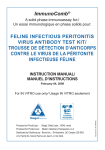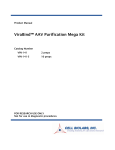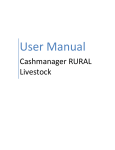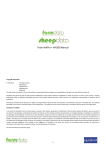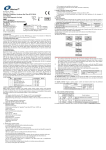Download ImmunoComb®
Transcript
ImmunoComb ® V. READING THE RESULTS To determine the IgG titer of Brucella specimens, compare the color intensity of the Comb's appropriate teeth with the color spot series on the enclosed CombScale table (see illustrations 9 &10 for details). OVINE BRUCELLA ANTIBODY TEST KIT The bottom spot on the ImmunoComb® tests for Brucella. Evaluate the results of each spot separately. Compare the specimen's color intensity with that of the positive control (C+) included INSTRUCTION MANUAL in the kit, in order to determine its titer. SUFFICIENT FOR 300 ASSAYS The positive control (C+) for Brucella is calibrated to a 1:32 titer (C.F.). I. INTENDED USE Specimens with an identical or higher color intensity than the positive control are This kit is designed to determine sheep serum IgG antibody titers for Brucella considered positive. melitensis. The negative control consists of non-immune sera and should be read as zero (S=0). Specimens with a color intensity lower than the positive control are considered ® II. WHAT IS THE ImmunoComb ASSAY? negative or non-immune. The ImmunoComb® is a self-contained portable kit. A sensitive test When a test color is darker than S6, it may indicate either an acute or a recent infection. which detects antibody levels in the blood or serum, the ImmunoComb® Proceed with the dilution process by transferring 5µl from the sample in compartment provides results within 40 minutes. A to a new sample well. Repeat the entire process. Read results using “2nd dilution titer” (see Fig.A). ® III. HOW DOES THE ImmunoComb WORK? Fig. A Relationship between the CombScale's value and the C.F. or S.A.T. Based on a solid phase immunoassay principle, the ImmunoComb® is a plastic card shaped like a comb, on which purified Brucella antigens are attached. into sample wells of the multi-compartment developing plate. 1: 80 Insert Comb into the sample wells so that antibodies from samples bind themselves to the antigens on the Comb. Non bound antibodies are washed out in the second compartment. The next compartment contains an anti-sheep IgG antibody labeled with an 1: 20 1: 10 1: 40 C+ 1: 20 1: 5 C.F. TITER 1: 160 S.A.T. TITRE Either immerse paper disks in sheep blood or take a serum specimen. Deposit 1: 10 enzyme. Immerse the Comb in this "conjugate". The bound antibodies will be 0 labeled. Insert the Comb into a compartment where the enzyme reaction takes 1 2 3 4 5 6 COMBSCALE S-VALUE place. This generates a color change which indicates the amount of antibodies present. The scale on the right side illustrates C.F. titer and the left side - S.A.T. titer, as Using the CombScale, convert the bottom spot's color intensity to the anti- outlined above. Assign a lower value when the color falls between CombScale color Brucella immunoglobulin level. windows. An Internal control indicates that the development is completed. Important The ImmunoComb® may be divided into three separate sections. Each segment The margin of error is similar to that of other enzyme immunoassay kit procedures. processes between 1-4 samples. Therefore, an error in one color scale window will not result in a wrong diagnosis. VI. INTERPRETATION OF RESULTS IV. HANDLING & STORAGE It is generally accepted that specimens containing titer 1:20 S.A.T. or 1:5 C.F. or 1. Store the kit under normal refrigeration: 2°- 8° C (36° - 46° F). greater, for B. melitensis, are considered “positive” or immune. In areas where Do not freeze the kit. eradicetion has been carried out without vaccination, each result that is darker in 2. Before conducting the test, maintain all kit elements and specimens at room color than the negative control should be taken as carrying an immune response temperature -- preferably for 60 minutes. Perform assay at room temperature of and should be retested. In areas where the vaccination program is based on rev- 20° - 25° C (68° - 77° F). 1 serotype B. melitensis, the kit will show both responses to vaccination as well 3. Avoid spillage and cross-contamination of solutions. as to carriers. In this case, different samples from the flock may give the mean 4. Mix reagents by inverting developing plate several times prior to use. result of the vaccination, while typically high responses of aborting ewes should 5. Do not mix reagents from different kits or from different compartments of one be assigned as positive . Fig. A shows a correlation between the CombScale’s kit. “S” values (1-6) to C.F. (right hand side) and S.A.T. (left hand side) titers. With 6. Do not touch teeth of ImmunoComb® double dilution, titers should be multiplied by factor of 1:40. Card. 7. When using developing plate, pierce cover of each compartment while strictly following test procedure instructions. DO NOT RIP OFF OR REMOVE COVER Note: The “S” values are not indentical to C.F. or S.A.T. The correlation was OF ENTIRE DEVELOPING PLATE ALL AT ONCE. calculated from results of clinical filed studies. 8. The ImmunoComb® kit contains inactivated biological material. Kit must be handled and disposed of in accordance with accepted sanitary requirements. Use large amounts of water to flush kit solutions down sewage/drainage system. 63OBR130 22/7/04 1 STEP-BY-STEP WITH ImmunoComb 6 Remove one ImmunoComb® from its protective wrapping and insert (print side facing you) in compartments of Row A. Gently move Comb up and down several times, then let incubate in Row A's compartments for 10 minutes. B. A. C. c 4 3 2 1 e Comb Scal + D. 6 E 5 De F. v p elo ing Pla te De lo ve pin la gP t When using 1/3 or 2/3 of a Comb break the Comb by folding back on notch 4 or 9 respectively. Keep the rest in its original sleeve for further use. The ImmunoComb® kit includes: A. 30 ImmunoComb® cards,each separately wrapped in an aluminum envelope; B. 30 developing plates; C. 30 specimen papers with pre-punched disks; D. One disposable tweezers; E. One calibrated CombScale color card; F. One tube of positive control serum and one tube of negative control serum, and a user manual. 7 10 Min - F 2 Min - E 2 Min - D 10 Min - C 2 Min - B 10 Min - A Perform assay at room temperature of 20° - 25° C (68° - 77° F). When using a paper disk When using a serum 1 De ve lo g pin Pla Pierce the cover of the appropriate section of compartment B with the tweezers. Follow same procedure for remaining rows at end of each incubation period. Gently shake off excess liquid onto a tissue. Insert Comb in Row B's compartment and let incubate for 2 minutes, shake-off and transfer Comb to Row C and incubate for 10 minutes. Similarly, the Comb is placed in Row D for 2 minutes, Row E for 2 minutes, and Row F for 10 minutes, allowing the color reaction process to develop. te 1 8 Pierce one of the sheep's veins. Take a specimen paper and saturate a prepunched disk with the blood. After the Comb has completed the cycle for Row F ,transfer it back to Row E. Incubate in Row E for 2 minutes to fix color. Use a pipette or a capillary tube. For testing a serum sample use 5 µl. 2 De 3 3 1 2 3 4 Dispense a sample into each well. When using the capillary tubes raise and lower the piston several times to achieve mixing. When using a pipette, mix by depressing the plunger a number of times. 5 6 7 8 9 10 11 12 R E S U LT S W I T H 4 5 6 7 8 9 10 11 12 Internal Control Insert the disk into well #1 of compartment A. Immerse totally in the liquid. Proceed with the other samples. C+ 3 Wait 60 minutes for extraction of antibodies. For control serum open the next 2 consecutive wells. Choose the most suitable color and read the titer in the yellow windows. c+ 6 5 4 3 2 1 Comb Scale REMEMBER: A DIFFERENCE OF ONE COLOR LEVEL WILL NOT AFFECT DIAGNOSIS !!! Mix the serum in the well. 1 2 Cat: Lot S. M : 5 6 7 8 Inte 9 10 11 12 rnal C ontrol 2 4 22/7/04 3 Do the same with the negative control serum in the next well. FINALLY, HOLD THE SLIDE IN THIS POSITION DURING READING. B. Read each of the spots separately: 10 Take 5 µl positive control serum (C+) and insert into well A next to the last sample. CombScale When the Comb is completely dry align it with the calibrated color CombScale. Compare the color resulting from the positive control (C+) sample to the color scale : slide the yellow ruler until the "C+" mark appears in the window corresponding to the color. c+ 4 3 2 1 5 6 Comb Scale 5 T H E A. Adjust scale with positive control: 9 Proceed to step 5. 63OBR130 Developed Brucella melitensis ImmunoComb® Cat: Lot S. M: 4 A I R D RY AND READ R E S U LT S te Cat: 11OBR100 Lot S. N: R E A D I N G When using a paper disk punch out a disk saturated with blood. la gP ImmunoComb® Internal control B. melitensis 3 Slit open the protective aluminum cover of compartment A with the tweezers, one well for each sample. 2 Slit open the protective aluminum covering of compartment A with the tweezers, one well for each sample. ve in lop 1 2



